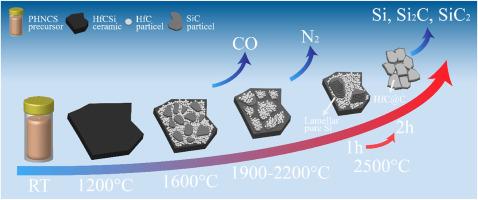非氧前驱体HfC-SiC陶瓷的超高温稳定性和SiC分解行为
IF 7.7
2区 材料科学
Q1 MATERIALS SCIENCE, COMPOSITES
引用次数: 0
摘要
HfC-SiC陶瓷具有超高温应用前景,但其在2500°C下SiC分解导致的结构降解仍未得到充分研究。在本研究中,采用液态非氧PHNCS前驱体,通过聚合物衍生陶瓷的方法成功制备了具有均匀纳米级微观结构的HfC-SiC纳米复合材料。2500℃热处理后,SiC发生明显分解,硅的挥发促进残余碳以石墨层的形式沉积在HfC颗粒上,形成HfC@C结构。商用碳化硅表现出比HfC-SiC纳米复合材料更少的分解。这可能是由于纳米级HfC颗粒在1900°C以上沉积在SiC表面,这些颗粒作为缺陷在极端温度下加速SiC分解。这些发现阐明了HfC-SiC陶瓷在超高温下的结构降解机理,为确定其最高使用温度和指导优化多相结构的设计提供了有价值的见解。本文章由计算机程序翻译,如有差异,请以英文原文为准。

Ultrahigh-temperature stability and SiC decomposition behaviour in HfC-SiC ceramics derived from non-oxygen precursor
HfC-SiC ceramics are promising for ultrahigh-temperature applications, yet their structural degradation due to SiC decomposition at 2500 °C remains underexplored. In this study, HfC-SiC nanocomposites with a uniform nanoscale microstructure were successfully fabricated via the polymer-derived ceramics route using a liquid, non-oxygen PHNCS precursor. Upon heat treatment at 2500 °C, significant SiC decomposition occurs, and the volatilization of silicon promotes the deposition of residual carbon as graphitic layers on HfC particles, forming a HfC@C structure. Commercial SiC exhibits much less decomposition than the HfC-SiC nanocomposites. This may be attributed to nano-sized HfC particles that precipitate on the SiC surface above 1900 °C, which act as defects and accelerate SiC decomposition at extreme temperatures. These findings elucidate the structural degradation mechanisms of HfC-SiC ceramics at ultrahigh temperatures and provide valuable insights for defining their upper service temperature and guiding the design of optimized multiphase architectures.
求助全文
通过发布文献求助,成功后即可免费获取论文全文。
去求助
来源期刊

Composites Communications
Materials Science-Ceramics and Composites
CiteScore
12.10
自引率
10.00%
发文量
340
审稿时长
36 days
期刊介绍:
Composites Communications (Compos. Commun.) is a peer-reviewed journal publishing short communications and letters on the latest advances in composites science and technology. With a rapid review and publication process, its goal is to disseminate new knowledge promptly within the composites community. The journal welcomes manuscripts presenting creative concepts and new findings in design, state-of-the-art approaches in processing, synthesis, characterization, and mechanics modeling. In addition to traditional fiber-/particulate-reinforced engineering composites, it encourages submissions on composites with exceptional physical, mechanical, and fracture properties, as well as those with unique functions and significant application potential. This includes biomimetic and bio-inspired composites for biomedical applications, functional nano-composites for thermal management and energy applications, and composites designed for extreme service environments.
 求助内容:
求助内容: 应助结果提醒方式:
应助结果提醒方式:


